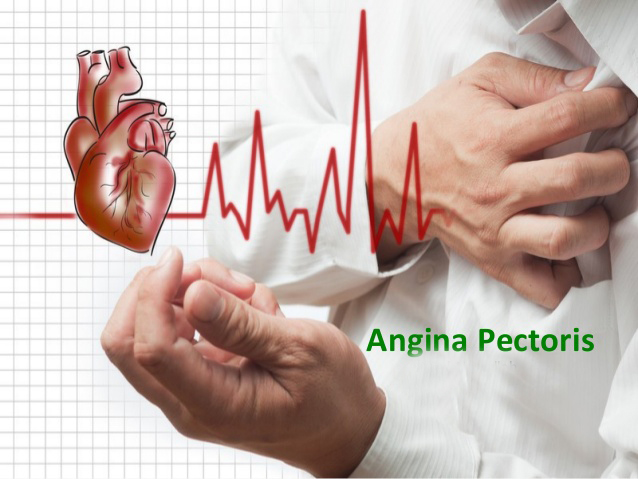
Angina Pectoric
Reduced blood flow to heart muscles causes chest pain called as angina pectoris. Angina is a symptom of coronary artery disease. A person may feel pain when insufficient oxygen-rich blood reaches the heart muscle. This reduced blood flow is caused by coronary artery disease. In coronary artery disease, there is an accumulation of plaque inside the coronary blood vessels. The pain associated with angina is typically described as squeezing, pressure, heaviness, tightness or pain in your chest. A common presentation as told by most patients is the feeling that ‘someone is standing on their chest’. The usual site of pain in angina is chest, but may also be felt in the shoulders, arms, neck, throat, jaw, or back.
Anginapectoriscan is a recurring problem or a sudden, acute health issue. Although angina is common, it can be hard to distinguish from other types of chest pain. The most common confounding factor is pain or discomfort of indigestion. Seek medical attention immediately if you have unexplained chest pain.
9,600+
Happy Patients
10
Qualified Doctors
500+
Successful Surgeries
100+
Insurance Partners
Angina can be of the following three types:
Stable Angina:In this type of angina, the pain is predictable and presents only during exertion or extreme emotional distress. It generally disappears with rest.
Unstable angina:This type of angina could be an indication of a heart attack. Unstable angina is angina pain that is different from your regular angina pain or pain that occurs while at rest. The characteristic feature of this type of angina is that it may occur more frequently, more easily at rest, feel more severe, last longer, or come on with minimal activity. In most cases, this type of angina gets relieved with medication. But, it is unstable and may progress to a heart attack. Intensive medical or surgical treatment or a procedure is required for relief.
Prinzmetal’s angina:Angina occurring at rest is called Prinzmetal’s angina. This may occur at rest, when sleeping, or when exposed to cold temperatures. The cause is mostly decreased blood flow to the heart muscle from a spasm of the coronary artery. This type of angina in most people is associated with coronary artery disease. These spasms occur close to the blockage.
Reduced blood flow to your heart muscles causes angina. Blood is a carrier of oxygen, which your heart muscle needs to survive. In situations where heart muscle isn’t getting enough oxygen, it causes a condition called ischemia. Coronary artery disease (CAD) is the most common cause of reduced blood flow to your heart muscles. The arteries of the heart (coronary arteries) can become narrowed by fatty deposits called plaques. This is called atherosclerosis.
Angina due to reduced blood flow is a supply problem, wherein the heart is not getting enough oxygen-rich blood. It might be interesting to note that a person may not always have angina if the heart arteries are narrowed due to fatty buildup. The reason is that during times of low oxygen demand — when you’re resting, for example — your heart muscle may be able to get by on the reduced amount of blood flow without triggering angina symptoms. When the demand for oxygen suddenly increases, like when you exercise, this can cause angina.
A positive family history of CAD or stroke indicates increased risk to develop unstable angina than in people whose families do not have these conditions. Other risks for unstable angina are related to lifestyle, including:
The typical features of chest pain and discomfort common with angina are a feeling of pressure, squeezing, fullness or pain in the center of your chest. The feeling experienced by some people is of as if someone is squeezing their chest, or feeling like a heavy weight has been placed on their chest.
There are variations in the severity, duration and type of angina. In case somebody has a new or changing chest pain, immediate medical attention should be sought. New or different symptoms may signal a more dangerous form of angina (unstable angina) or a heart attack.
Most common form of angina is stable angina. It typically occurs with exertion and goes away with rest. When somebody previously healthy experiences a new onset chest pain, it’s important to see the doctor to find out what’s causing the chest pain and to get proper treatment. If your stable angina gets worse or changes, seek medical attention immediately.
Characteristics of Stable angina includes:
Characteristics of Unstable angina(a medical emergency):
Characteristics of Variant angina(Prinzmetal’s angina):
Angina in Women
Symptoms of angina in women can be different from the classic angina symptoms. For example, a woman may have chest pain that feels like a stabbing, pulsating or sharp form of chest pain rather than the more typical vise-like pressure. Associated symptoms like nausea, shortness of breath or abdominal pain are more common in women. These differences may lead to delays in seeking treatment.
To diagnose angina, your doctor will start by doing a physical examination and asking about your symptoms. You’ll also be asked about any risk factors, including whether you have a family history of heart disease.
There are several tests your doctor may order to help confirm whether you have angina:
Heart attack is the most dangerous complication to be concerned about with angina. Common symptoms of a heart attack include:
Seek emergency medical consultation if you have any of these symptoms.
Angina treatment options are many, including lifestyle changes, medications, angioplasty and stenting, or coronary bypass surgery. Treatment aims to reduce the frequency and severity of your symptoms and to lower your risk of heart attack and death.